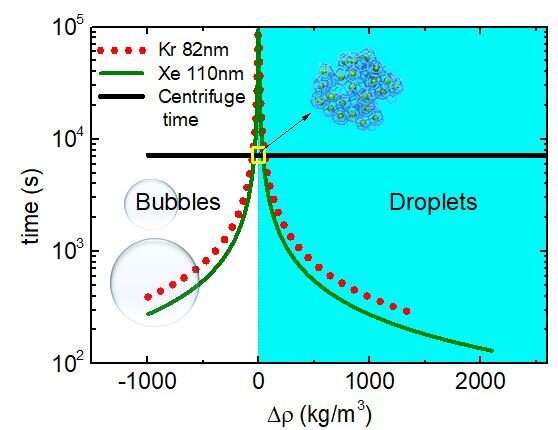Nanobubbles are extremely small (i.e., nanoscopic) gaseous cavities that some physicists observed in aqueous solutions, typically after specific substances were dissolved in them. While some studies reported the observation of these incredibly tiny bubbles, some scientists have argued that they are merely solid or oily residues formed during experiments.
Researchers at Centro de Investigación y de Estudios Avanzados Unidad Monterrey and Centro de Investigación en Matemáticas Unidad Monterrey in Mexico have recently carried out an experiment aimed at further investigating the nature of these elusive and mysterious objects, specifically when xenon and krypton were dissolved in water. Their study, featured in Physical Review Letters, identified the formation of what the team refers to as “nanoblobs,” yet found no evidence of nanobubbles.
“Our aim was to create xenon and krypton nanobubbles using a clean method,” Carlos Ruiz Suarez, one of the researchers who carried out the study, told Phys.org. “I must say that there many scientists claim that nanobubbles, despite their use in many applications, do not exist. Rather, it is thought that they are oil/solid contaminants formed during the experiments.”
To solve the “mystery” of nanobubbles, Ruiz Suarez and his colleagues devised a “clean” method that should have theoretically allowed them to produce “real” nanobubbles. This method entailed dissolving the two noble gases xenon and krypton in water, by applying high pressure to them, and then depressurizing and inspecting the resulting liquid.
The team assessed the results of this procedure in both molecular dynamics simulations (MDSs) and laboratory experiments. While they actually observed nanobubble-like particles, when they analyzed these particles they were surprised to find that these were most likely gas-water amorphous structures, rather than gaseous bubbles.
“To bring together the noble atoms to nucleate into bubbles, we needed to increase their concentrations in the water medium,” Ruiz Suarez explained. “By performing MDSs, we found that the correct proportions between water molecules and the noble atoms were around 30 water molecules/atom. Thus, we needed to build a high- pressure cell to force the atoms to dissolve in water by pushing the gas inside.”

Xenon and krypton are two hydrophobic gases. This means that they can only enter water and aqueous solutions under high amounts of pressure (over 360 bars or atmospheres). Once they enter water, however, they can bond with each other through hydrophobic and van der Waals forces.
“There is currently no way to see inside the cell, but we supposed that the bubbles existed because we believed our MDSs,” Ruiz Suarez said. “The next step for our work was to depressurize the sample and see the bubbles. However, to our great surprise, there were no bubbles, but something else: nanostructures formed by gas and water, which we called nanoblobs. These are sui generis structures that give rise to clathrates hydrates.”
The existence of nanobubbles remains a debated topic in particle physics and the recent work by these researchers could help to solve this mystery. Just like xenon and krypton, many other gases used to form nanobubbles can also form clathrate hydrates (i.e., water structures with molecules inside them). Overall, the team’s findings thus suggest that what many previous studies identified as “nanobubbles” could instead be these amorphous nanostructures formed by clathrate hydrates.
“It is important to remark that when an existing physical theory cannot explain experimental findings, physicists like to name it as a catastrophe,” Ruiz Suarez said. “Since nanobubbles have high pressure inside them (the smaller they are the higher the pressure), theory says that their lifetime is very short (of the order of microseconds). However, observations revealed that they exist for much longer, so this has been called the Laplace Pressure Bubble Catastrophe.”
If the findings collected by this team of researchers are valid and reliable, they could greatly contribute to the present understanding of nanobubbles. Essentially, their findings suggest that the Laplace Pressure Bubble Catastrophe does not exist, as previously observed “nanobubbles” are instead “nanoblobs,” or alternative structures resulting from clathrate hydrates in experimentally used gases.
“We are now building an experimental apparatus that will allows us to see inside the cell and observe the nanobubbles at high pressure,” Ruiz Suarez said. “We would like to see their evolution when we decrease the pressure and the moment when they become clathrate hydrates. Meanwhile, we are also studying other important gases like oxygen and carbon dioxide.”
Mystery of the nanobubbles solved
Angela M. Jaramillo-Granada et al, Xenon and Krypton Dissolved in Water Form Nanoblobs: No Evidence for Nanobubbles, Physical Review Letters (2022). DOI: 10.1103/PhysRevLett.129.094501
© 2022 Science X Network
Citation:
A new experimental study tackles the unsolved mystery of ‘nanobubbles’ (2022, September 13)
retrieved 14 September 2022
from https://phys.org/news/2022-09-experimental-tackles-unsolved-mystery-nanobubbles.html
This document is subject to copyright. Apart from any fair dealing for the purpose of private study or research, no
part may be reproduced without the written permission. The content is provided for information purposes only.